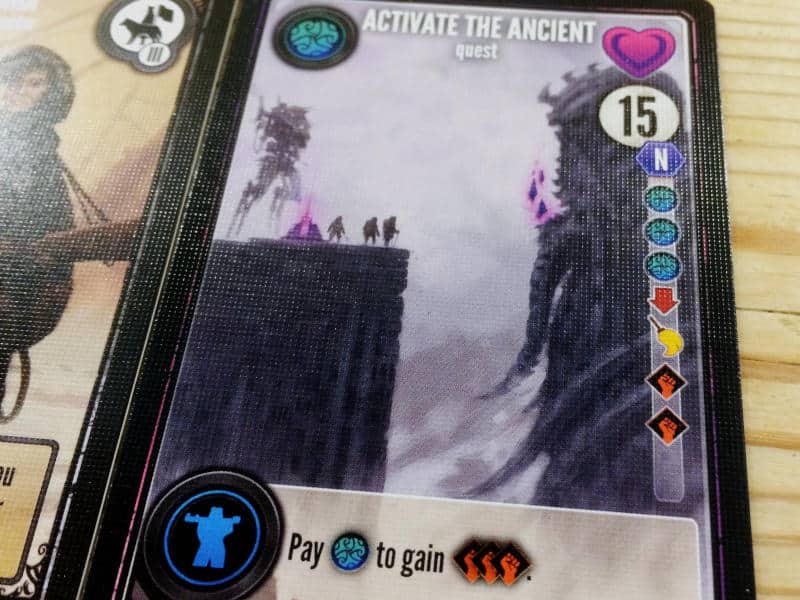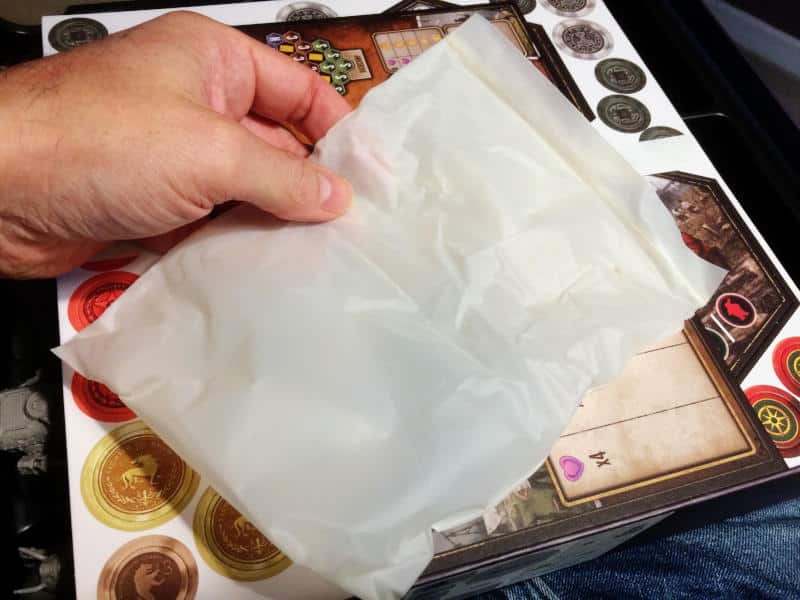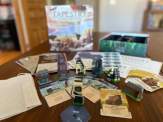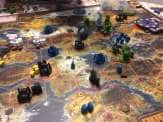| Release Date: 2023 | Players: 1-5 |
| Designer: Jamey Stegmaier | Length: 90-150 minutes |
| Artist: Jakub Różalski | Age: 12+ |
| Publisher: Stonemaier Games | Complexity: 3.0 / 5 |
| Plastic (by weight): 20% | Air (by volume): 25% |
Siberia: a vast area of over 13 million square kilometres, which consists of taiga, tundra and even temperate forests. From the north of this region, where temperatures regularly drop below -25°C, come reports of a massive meteor having crashed. Not only that, the team who went to investigate the impact crater lost contact and never returned. Rumours are spreading of a strange parasite that possesses all living things in the region. After a team sent to rescue the first group also fails to return, heroes from the now long-forgotten war in Europa decide to explore for themselves. They borrow mechs and head to base camp. From there, they start their Expeditions by Jamey Stegmaier from Stonemaier Games.
Listen to the Audio Version
Intro Music: Bomber (Sting) by Riot (https://www.
Title Music: Aeterna (No Choir) by Two Steps From Hell (https://soundcloud.
Music: The Rythym Of Creation by Tim Kulig
Free download: https://filmmusic.
Licensed under CC BY 4.0: https://filmmusic.
Sending Out Your Expeditions
The grand introduction really sets the scene and the challenge for players seems clear: venture north to find the meteor and gain glory to become the most revered hero. You immediately know what the game wants you to do. The rulebook goes further and says that “Expeditions is a competitive, card-driven, engine-building game of exploration” and that’s a really good summary.
Unfortunately, Expeditions is sold as “a sequel to Scythe“. So you immediately imagine the constant threat of battles between mechs and the odd actual skirmish. You remember the importance of gaining resources to build upgrades and increase your force. The thing is, Expeditions is really a very different game to Scythe. Sure, both are set in the same fictional world created by the amazing illustrator Jakub Rozalski. Both games also have similar symbology and mechanisms.
However, the overall gameplay of both games bears very little resemblance. So if you never played Scythe, then that’s absolutely fine. In fact, in some ways, it’s probably better if you haven’t played it.
At the core, Expeditions is a really lovely game of moving your mechs around a variable map made up of three regions, each consisting of randomly placed hex tiles. Some tiles are facedown, so as you explore, you discover the lay of the land. You use the benefits of the hex locations to gain points, draw more cards, complete quests and otherwise build your engine. When you play cards you increase your guile or power, which are the main two resources in the game. You place workers on these cards to gain benefits, which also help you get points and further build your engine.
Clever Mechanisms
There are some really clever mechanisms in Expeditions, some borrowed from Scythe, but implemented in a more interesting way. My favourite is the way you decide which of the three basic actions, move, play and gather, you take on your turn. One of the three actions is covered up by your action cube, meaning you can only take the two uncovered actions. For example, the cube covers up play, so your actions are move and gather.
Additionally, every turn you have to move the cube to a different action. So if you moved and gathered on your last turn, then you can only move and play or play and gather on your next turn. It seems insignificant and maybe pointless, but it does force you to plan ahead. It also leads to turns where you have to do an action you didn’t need.
I also love how you get new cards. Rather than there being a market row, cards are placed within the hex map. You can gain these cards by using the benefit of certain hexes or cards, but there are other benefits that only allow you to choose from the cards adjacent to your mech’s location. So where the cards are positioned is important, which I’ve not seen in other games before.
The way you manage your hand is also interesting. Like in many deck-building games, you play cards from your hand. These go into your active row. Place a worker on the card to gain a benefit. Some cards affect cards already in the active row. Additionally, cards you gain also go into the active row, which means you can’t immediately use them. So your active row is a mix of a discard pile and a way of activating previously played cards.

Keywords and Symbols Overload
The thing is, while Expeditions is perfectly enjoyable, getting there is hard. The rulebook’s length isn’t an issue as such. The main issue is that there are dozens of keywords and dozens of symbols to learn. The terminology is also often confusing. For example, you meld meteorites, you gather benefits on hex locations and you boast to place a glory star. Discarded cards go into your active row, while the sweep is what we would commonly know as the main discard pile.
It gets worse with the symbols. Solving a quest makes sense, but why quest cards are represented by the heart symbol from Scythe isn’t clear, until you learn that stars are worth a certain number of points based on how many quests you solved. That’s how popularity worked in Scythe which was represented by a heart in that game.
The meteorite symbol is clear, but the icon for melding is very different. It’s not obvious that they are linked. It would have made more sense to use the meteorite symbol as the basis for melding, maybe adding a spanner or something. The icon for upgrading is a spanner, which sort of goes with the cog icon for item cards.
There are cards that use symbols and words for the same thing in the same sentence. For example, one card allows you to decrease your guile if you have 10 and it uses the icon for guile as well as the word. Why the icon isn’t used in both places on the same card is not clear to me.
Speaking of problems with icons, those printed along the right-hand edge of quest cards are super tiny. They are very hard to identify and feel like they’re an afterthought.
Redeeming Expeditions
Expeditions clearly recognizes some of its flaws. There are two double-sided player aid cards that contain most of the symbols and keywords. These will be very much in demand during your first couple of games. You will also not be putting down the rulebook for at least two games. It would have benefited from a glossary, but at least there is a summary of the main symbols and keywords on the back.
Once you cut through the mountain of terminology and symbology, you get to a really pleasant little game. Sure, it does take quite a bit longer than the hour to an hour and a half printed on the box, which is a bit too long for the type of game Expeditions is. Yet, it’s still very enjoyable to play.
As a product, the game is worth every penny. There are wonderful mech miniatures and plenty of wooden tokens, including custom worker meeples. The card stock is thick and every card is linen-finished. The hex tiles are made from thick cardboard, like all of the cardboard components. It’s the level of quality that we have come to expect from Stonemaier Games. Of course, that quality doesn’t come cheap.
Saying that, the company is doing a lot to reduce plastic in their games. Yes, there are plenty of plastic minis and a plastic insert. At the same time, the plastic bags are biodegradable. The punchboards had a paper bellyband, but the cards still came in plastic wrap. On balance, Expeditions is a game that still contains a lot of plastic.

Pleasant Expeditions
At the end of the day, Expeditions feels like it could have benefited from another few months of development to file off some of the rough edges, streamline the terminology and icons and make the overall playing time shorter. The price is also a bit high for my liking. Yet, deep down there is a really interesting game that wants to burst out. So while I will happily play Expeditions, I’m not sure I would have bought it myself, if I had to have paid the full price for it.
Keeping the blog running takes time and resources. So if you can chip in, that would be amazing.
Useful Links
- Expeditions: https://stonemaiergames.
com/ games/ expeditions/ - Rulebook: https://www.
dropbox. com/ sh/ f2tekc23yvb27w3/ AACnyTCcjoiT6s-N1hgFx4DNa/ Expeditions? dl= 0& amp;subfolder_ nav_ tracking=1 - Stonemaier Games: https://stonemaiergames.
com/ - BGG listing: https://boardgamegeek.
com/ boardgame/ 379078/ expeditions - Scythe review: https://tabletopgamesblog.
com/ 2019/ 01/ 19/ scythe/
Videos
Transparency Facts
I feel that this review reflects my own, independent and honest opinion, but the facts below allow you to decide whether you think that I was influenced in any way. Please also read my Ethics Statement for more information.- I was sent a heavily discounted review copy of this game by the publisher.
- At the time of writing, I have not received financial support from the publisher or anyone working on their behalf.
Audio Version
Intro Music: Bomber (Sting) by Riot (https://www.
Title Music: Aeterna (No Choir) by Two Steps From Hell (https://soundcloud.
Music: The Rythym Of Creation by Tim Kulig
Free download: https://filmmusic.
Licensed under CC BY 4.0: https://filmmusic.
Playlist
These are the songs I listened to while I was writing this review:






